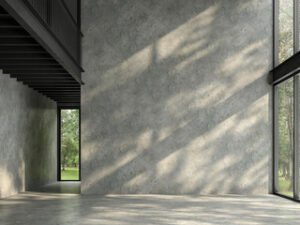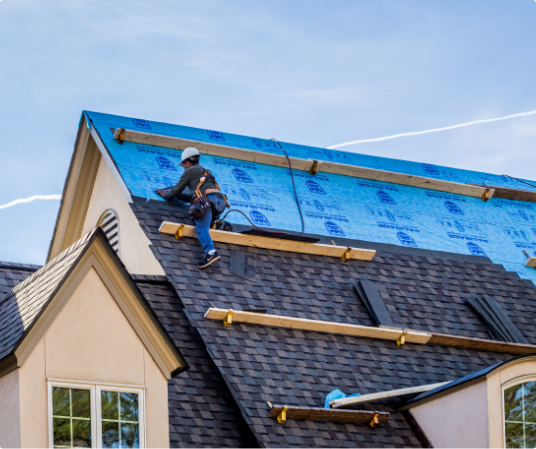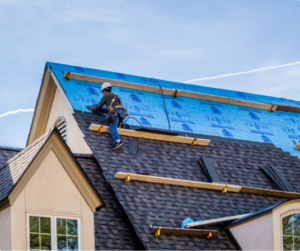Using a patented architectural concrete system, Stone-Crete can simulate the look of stone or rock at a fraction of the cost. It’s a perfect solution for non-structural walls, such as subdivision entryways and highway sound barriers.
Decorate premade stepping stones with a mudlike layer of mortar mix and pebbles, leaves, or other decorative items. The entire process takes only half an hour with a quick-setting concrete mix. Keep reading the article below to learn more about Stonecrete Artisans.
ChiselCrete is the latest product to be added to their line up of fencing products. Designed to simulate the look of dry-stacked stone walls, this product is manufactured at the plant in concrete molds and then shipped to the jobsite ready to erect saving both time and money on the installation process.
The concrete is made with recycled materials and is integrally colored eliminating the release of VOCs on the job site. The design utilizes a post and panel system and is available in a wide range of heights to meet the needs of any project. Unlike traditional brick or masonry walls, this design requires no mortar and can be easily repaired as needed.
A new innovation in stack and carve concrete, this unique material brings a whole new level of artistry to outdoor projects. By combining the durability of concrete with the aesthetics of stonework, this product unlocks endless possibilities for any type of landscape or hardscape project.
Staintec, the company behind this innovative product, has a dedicated team of professionals that can assist with any size project. They offer manufacturer consulting and on-site project support. In addition, they can provide detailed design and layout assistance as well as on-site training to ensure the proper use of the material for your specific application.
Unlike other masonry products that deteriorate and need constant attention, concrete withstands the elements and lasts for generations with minimal maintenance. Whether you are building a retaining wall, patio or sidewalk, this material is the best choice to create a beautiful space that will stand the test of time.
The unique three-component system uses a series of admixtures and surface treatments to transform low slump concrete into form-free, slow-setting concrete that can be carved or shaped to mimic realistic stonework. The product consists of Wall Aid, a mid-range plasticizer that allows for higher early strength formation, Slow Set, a set retarding admixture, and Easy Slick, a surface finishing treatment with delayed hydration to extend tooling time. The product can be used to make decorative columns, pillars and beams or to build free-standing walls for residential or commercial projects.
Ashby Countertop System
Concrete contractors have a number of options when it comes to counters, including GFRC, concrete slabs and stack and carve. Each method has its pros and cons. For instance, slabs allow the countertop to be poured in one piece, which reduces labor and cleanup time. However, they are more prone to cracking than a countertop made of sprayed GFRC.
Stack and carve, on the other hand, gives contractors more control over shape and appearance. It also allows them to use unique edge forms to add texture and color to the surface of the countertop.
Another benefit of stacked and carved concrete is its durability, which can last longer than traditional stone countertops. Additionally, a concrete slab can be installed over an existing countertop without the need for costly demolition or plumbing changes.
A new product called VertaStone is revolutionizing the way people create outdoor concrete structures. It is an innovative series of admixtures and surface treatments that transform low slump concrete into form-free concrete that can be molded or sculpted to mimic realistic stonework. This system is ideal for landscaping, patios, pool decks and retaining walls.
In the past, most contractors used concrete mixes made of preblended ingredients that were purchased at local hardware centers. Those products typically contain accelerators, superplasticizers and pozzolans that help to produce a durable countertop mix. But many of those additives can alter the physical performance and look of the final product, which means you lose some flexibility when using these preblended products, says Jeff Girard of the Concrete Countertop Institute. When you make your own mix, he says, you can use additional additives like colorants and stains, as well as specialty aggregates and other materials, to strike the perfect balance between aesthetics, workability and physical performance.
To get the right look with a bilevel countertop, for example, you can add a product like Marbleizer to the concrete. This produces a look suggestive of water-worn rock in a riverbed or patterns in beach sand at low tide, but without the ridges and unevenness of real stone.
To create a beautiful finished countertop, you can add color to the concrete mix before pouring, stamp or stencil patterns on the wet concrete, press shells, stones or other objects into it for ornamentation and add custom edges. Once the counters are cured, they can be waxed to protect the concrete from scratches and abrasions.
Countertops
There are countless countertop options available today. From natural stone to concrete to recycled glass, each has its own unique style that can be adapted to suit any kitchen design. When it comes to choosing a material for your countertops, there are several factors you should consider, including color, durability and stain- and scratch-resistance.
Granite is a durable material that offers a range of colors and textures that complement any design style. It is a popular choice for luxury kitchens and can be found in many home improvement stores or kitchen showrooms. Its beauty stands the test of time, allowing you to add a timeless classic to your home.
Marble is another natural stone that can be used for countertops and features a classic elegance. It is a porous material that requires regular sealing, but it provides an elegant look to any kitchen. It can also be combined with other materials for a unique appearance, such as quartzite. Marble is available in solid slabs, modular marble tiles and prefabricated marble pieces. Marble can be honed for a polished finish or left with a more rustic surface that still offers high performance.
Slate countertops are a great option for those who want an earthy look in their kitchen. Its deep gray or black color creates a striking contrast with white wood cabinetry and backsplashes. Slate is durable and heat-resistant, making it an excellent choice for a busy kitchen.
Concrete countertops sound cold and drab, but they can be dyed most any color and molded into a variety of shapes to fit any kitchen. They can be made to resemble natural stones like granite, or they can be textured or inlaid with materials such as sea shells and broken tiles for a unique visual appeal. Concrete can be sealed with a chemical impregnator, or you can use a PH balanced or neutral cleaner to keep it looking its best.
Corian is a solid surface material that is a hybrid of polymer and natural materials. It is available in a wide range of colors and can be cut, sanded and polished to minimize seams and create a seamless look. It can resemble the look of marble, quartz and porcelain, but it is often less expensive.
Stepping Stones
Stepping stones provide a safe, easy-to-follow path for visitors or for navigating between garden beds or other features in your landscape. They also add to the aesthetic of the space. You can choose from a variety of materials, colors and textures to create a unique and eye-catching design.
When choosing a stepping stone shape, consider existing elements in the landscape and architectural features of your home. Unusual shapes like ovals and circles can meld seamlessly with organic design styles, while geometric forms can bring a modern look to your yard. Alternatively, you can opt for a classic rectilinear walkway that offers continuity to longer paths.
For those who prefer a more rustic style, natural stone stepping stones may offer a more attractive alternative to concrete slabs. While they may not be as durable as concrete, natural stone stepping stones have a unique texture and color that can complement any landscape. They are also typically easier to maintain than concrete stepping stones. However, they should be regularly checked for cracks and chipped edges. If necessary, the cracks can be repaired with a quality stone sealer.
If you want your stepping stone pathway to last for years, you’ll need to ensure it has adequate drainage. Too much water can erode the surrounding soil and harm your stepping stones. During your regular maintenance checks, make sure the stepping stones are not sitting in water for extended periods of time and that there is sufficient drainage underneath them.
You can also protect your stepping stone surface from damage by using a non-slip spray or coating to increase safety and gripping power. This can be particularly helpful if your landscape includes a steep slope or wet areas.
For the best results, you should spray or coat your stepping stone surfaces with a product that can be used year-round. This will help to prevent damage from freezing and thawing cycles in colder regions. It is also a good idea to use deicing salts sparingly. Sodium chloride can damage and discolor stepping stones.




